Szczecin
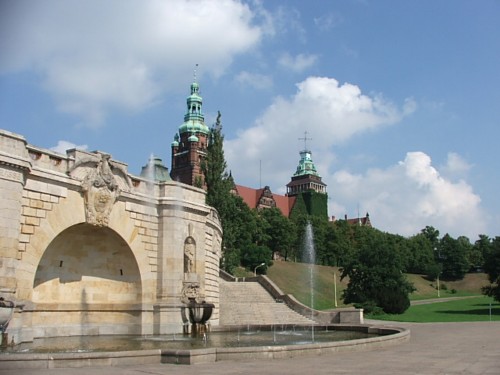
Szczecin. The terrace between Wały Chrobrego and the river – with the county administration building in the background
Distance
Distances around: Kołbaskowo (German border) 14 sv, Chojna 67 sv, Świnoujście (ferry port): 108 nv, Międzyzdroje 110 n, Wolin 81 n, Police 18 n, Kamień Pomorski 88 no, Goleniów 42 no, Nowogard 65 no, Stargard Szczeciński 37 island, Pyrzyce 46 lake, Gryfino 29 s.
Population
411.900 (2004)
Location and history:
Access roads to Szczecin: By land from Germany via Kołbaskowo or Lubieszyn; by sea via Świnoujście; by plane to the city airport at Goleniów.
Szczecin is the largest city in northwestern Poland, a port city and at the same time the county town of West Pomerania. The town is located mainly on the west side of the river Odra. On the east side of Odra are the suburbs. The oldest part of the city lies on the river itself.
Szczecin is an old town; a Slavic settlement existed here as early as the 8th century. In the oldest records, the town is called Sasin or Sadzin. In 1124, the city became Christian; Bishop Otto von Bamberg was sent to the city by the Polish prince Bolesław Krzywousty (“offbeat mouth”).
Szczecin was under Polish supremacy for several periods in his earliest history. However, from 1184-1227 the city – along with the rest of Pomerania – was under Danish rule. The first German-speaking people came to Szczecin in the 12th year. and since then the German influence gradually grew.
Szczecin was granted commercial property rights in 1243, and the city became the seat of a princely residence. Subsequently, the city began to play a significant political role in Pomerania. In 1278 Szczecin became a member of the Hanse Association.
The Gryfit dynasty ruled for over 500 years in the Principality of Pomerania and created here an independent state that acted as a buffer state between Poland, Brandenburg and the Crusader state. The last prince of this dynasty died childless in 1637. In 1648, Pomerania was divided between Brandenburg and Sweden; Szczecin came on Swedish hands.
By the peace agreement in Stockholm in 1720 after the Great Nordic War, Szczecin was incorporated in Prussia as the provincial capital of the province of Pomerania. The Prussian authorities made Szczecin a strong military center with strong fortifications around the city.
During World War II, 60-70% of the buildings, 70-80% of the port and 90% of the industrial companies were destroyed. Worst, it went beyond the central districts, including the Old Town. On April 26, 1945, Szczecin was captured by the Soviet army, and a Polish city government began its operations on July 5, 1945.
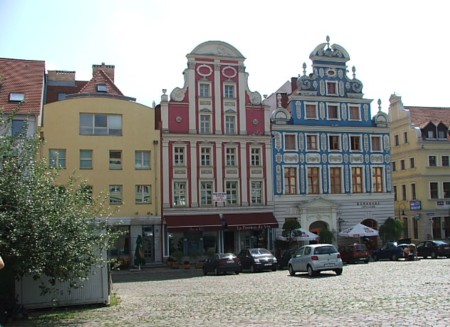
Reconstructed houses in the old town near the old town hall
Tourist attractions:
Sights in central Szczecin
Kościół św. Jana Ewangelisty (St. John the Evangelist Church):
We start from the central part of the city, a little southwest of Nabrzeże Wieleckie along the Odra River. Here at ul. Ducha iwiętego is the 14th-century Gothic-style church of St. John the Evangelist. Fragments of ancient polychromy can be seen on the walls and on a pillar, tombstones of 1378 and 1676 as well as an organ from the second part of the 18th century. A rectory was built (facing the river) in the years 1982 – 1985.
Most Długi (Langebro) :
Shortly northeast of the church, the bridge Most Długi (Langebro; built in 1957) crosses the river where a bridge was already in the year 1283. From the bridge you reach a series of stairs down to Bulwar Piastowski, which runs along the river Odra.
Ratusz Staromiejski (Old Town Town Hall):
Behind Nabrzeże Wieleckie we find the Old Town Town Hall, located at ul. Mściwoja 8 and houses Muzeum Historii Miasta Szczecina (Szczecin City History Museum). The building dates from the 15th century, and although it was rebuilt in the 17th century in Baroque style, after the Second World War it was rebuilt in Gothic-Baroque style. Today, this area is trying to recreate 18th and 19th century buildings.
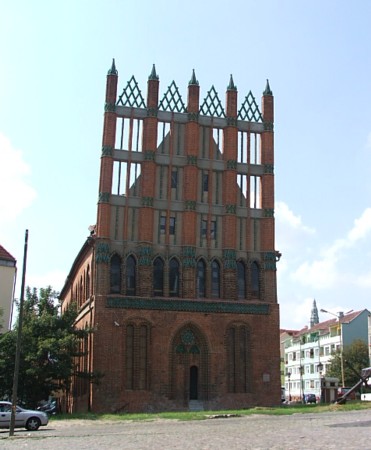
Old Town Town Hall. The current building was erected approx. 1450; it now houses a city history museum
Loitz Palace:
Not far from the town hall at ul. Grodzka, is a house dating from 1547, which belonged to one of the city's wealthiest families, the Loitz family. This house now holds Liceum Sztuk Plastycznych (Kunsthåndværkerskolen).
Zamek Książąt Pomorskich (The Castle of the Pomeranian Princes):
Ul.Grodzka continues in the direction of Wzgórze Zamkowe (castle hill) with the Castle of the Pomeranian Princes. From here, the rulers of different times controlled the river traffic. In 1982, the castle was rebuilt (which was leveled to the ground in 1944). The castle and surrounding area are now one of the city's most attractive places. The castle serves as a cultural center. In the evening it is beautifully illuminated and here people come to concerts and theatrical performances. Often there are also outdoor shows here.
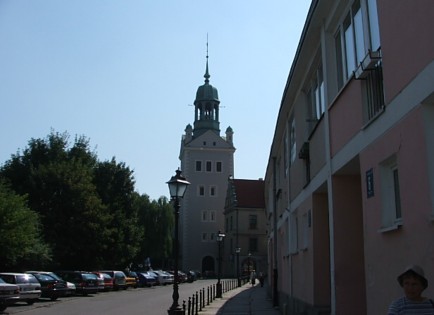
The castle seen from Korsarzy Street
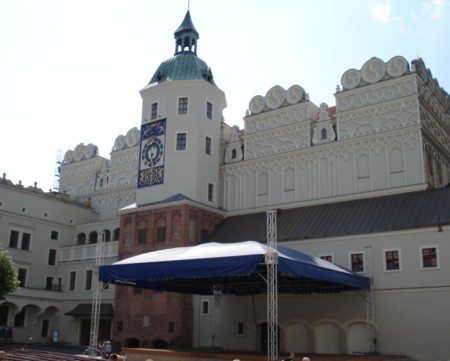
From the castle courtyard
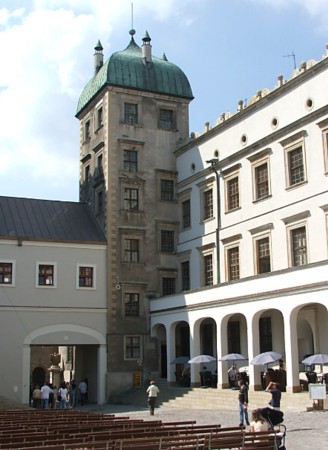
The castle courtyard with the entrance
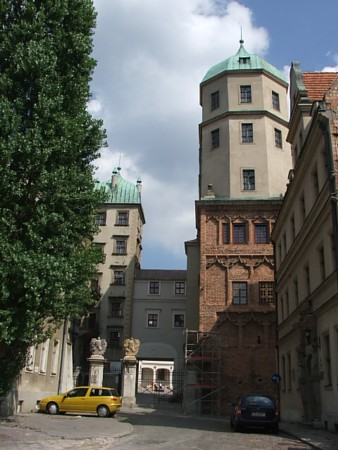
The entrance to the castle as seen from ul.Grodzka
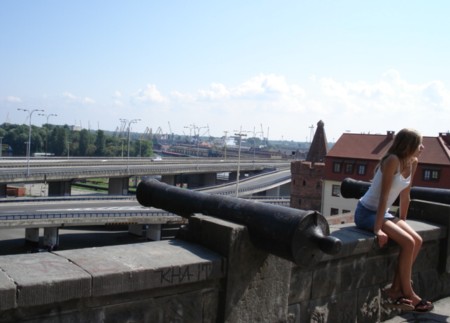
View from the castle's bastions to the east – across the large traffic artery Trasa Zamkowa and towards the river
IN Muzeum Zamkowe (Castle Museum) at ul. Korsarzy 34 shows various archaeological finds and in the basement a crypt with 6 princes sarcophagi. In part of the castle there are exhibition rooms. Noteworthy is also the clock on the tower (from 1693), Prince Barnim on the 3rd.‘s commemorative plaque from 1543 (under the arcade), the founding tablet with the year 1616 and the Pomeranian genealogy on the coin building. The museum is open: Tuesday to Sunday from 1 p.m. 9am to 5pm. There is a very nice view of the town, river and harbor of Wieża Dzwonów (bell tower), which is 35 m high and has 200 steps. In the tower there is a copy of a sculpture by St. Otto von Bamberg and a bell from the year 1500. Every day at 12 o'clock a horn signal is blown from here. You can also sit in the cafe up on the terrace and look out over the river.
Kościół śś. Piotra in Pawła (Church of Saint Peter and Paul):
Close to the castle at ul. Wyszaka stands the Gothic Peter and Paul Church of the 15th century. In the church there is a ceiling painting depicting the Holy Trinity, 17th-century tombstones, brass chandeliers, a limestone treasure chest with sculpture by Peter and Paul. The portal itself, the monumentally ornate main entrance, is from the 14th century, and on the outside the church is decorated with depictions of heads of fishermen and the town's citizens of the 15th century.
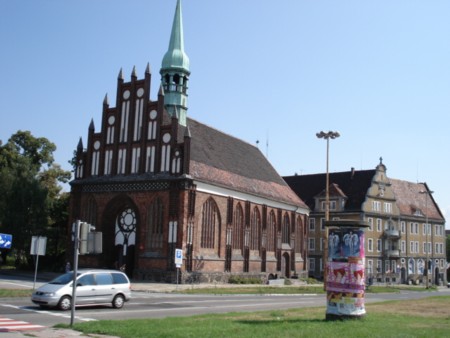
St. Peter and Paul's Church
Wały Chrobrego (Chrobry Violence):
If you proceed to ul. Małopolska and goes east towards Odra and from here turn left on ul. Jarowita, then on your right, you come to the street Wały Chrobrego (Chrobry violence; the name comes from Bolesław Chrobry (“the brave”) - the first Polish king, crowned in 1025). It is a very presentable and picturesque district. Here was an old fortification. Now a 19 m high and 500 long terrace has been built. From here there is a beautiful view of the harbor, the canals, and the grain chamber from 1936.
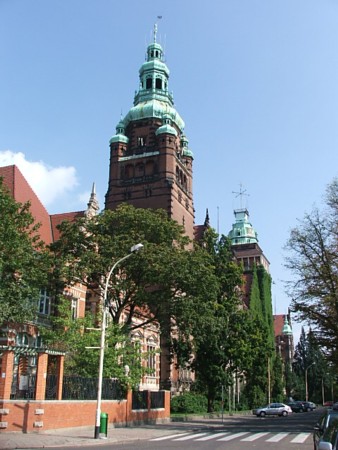
The county administration building seen from Wały Chrobrego
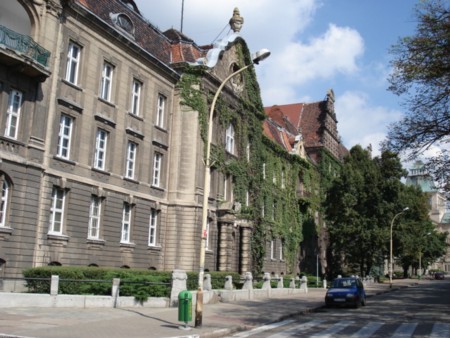
Naval College at Wały Chrobrego
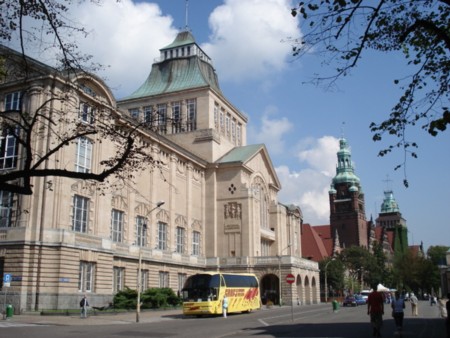
The theater and museum building at Wały Chrobrego
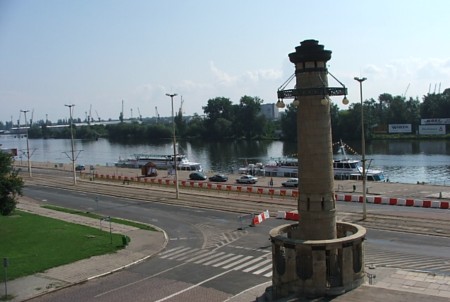
View from the large Haken terrace facing the river and Grodzka Island
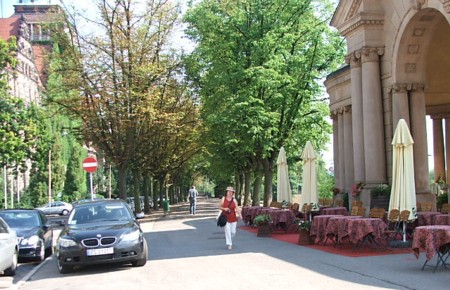
From Wały Chrobrego. To the right is the café in the north of the two beautiful pavilions that flank the Haken terrace
Wide stairs lead down to the river; north of this lies Dworzec Morski (the Port Terminal), from which various port excursions are based. On a 2 – 3 hour excursion you can see the whole Szczecin's port , which is operated by 8-9000 ships a year. OnWały Chrobrego is located Wyzsza Szkoła Morska (Naval College), a division of Muzeum Narodowe (National Museum) and Theater Współczesny (The Modern Theater). The former museum building formerly housed a maritime museum, the collections of which have now been transferred to the city museum.
Park im. Stefana Żeromskiego :
Behind the district adjacent to Wały Chrobrego lies Stefan Stefaneromski Park (SZ – Polish author). The park covers 25 hectares and has many interesting tree and shrub species. If you walk from Wały Chrobrego in the direction of the park, you come behind the Modern Theater building past the monument of the greatest romantic poets of the Poles Adam Mickiewicz .
*Brama Królewska (Kongeporten): *At Place Hołdu Pruskiego (Prussian tribute site) (on the eastern side of Plac Żołnierza Polskiego) stands a triumphal arch: the King's Gate. This triumphal arch was erected in the years 1725 – 27, drawn by Cornelius van Wallrawe to commemorate the fact that Szczecin had become Prussian in 1720.
Muzeum Narodowe (National Museum):
On both sides of ul. Staromłyńska is the National Museum. Part of the museum is housed in the former Polish Headquarters Assembly (Sejm Stanów Pomorskich) building , an 18th-century Baroque palace designed by architect van Wallrawe; here exhibits Pomeranian art from the 13th – 17th centuries; on the opposite side of the street, a classic 18th-century building houses a gallery of modern Polish art. In the collection of ancient art you can see some carved columns from the Danish monastery in Kołbacz.
Bartz Mansion :
In a complex of buildings next to the Gallery of Modern Art one finds the Bartz mansion or the Velthusen mansion; the mansion has wine motifs on the facade, both men being merchants and trading wine. The mansion is also known by the name The Mansion Under the Heads because of the 20 sculptures of the heads of well-known composers who adorn the walls of the building.
Place Orła Białego (White Eagle's Square):
If you go south on ul. Staromłynska comes to Plac Orła Białego, formerly called Rynek Koński (Horsetorvet); The site was the marketplace for the merchants in the newly developed city, the so-called Nowe Miasto (The New Town). Here stands an old well – which is at the same time fountain – in Baroque style. Also in the square is a Flora monument and Grumbkow Mansion from the early 18th century. Grumbkow's mansion is also called the Mansion Under the Globe because of the globe that adorns the main entrance to the mansion.
Cathedral: Saint James the Apostle Church :
From the White Eagle Square, there are only a few steps to St. James the Apostle Basilica (basilica means Old Christian Church); until 1983 the building was called Cathedral. It is the oldest church in the city; Construction began in 1187. The church was completely ruined after the world war, but was rebuilt between 1972 and early 1980’s. After the reconstruction, the church got its original appearance as a three-ship Gothic church. It's a very big church.
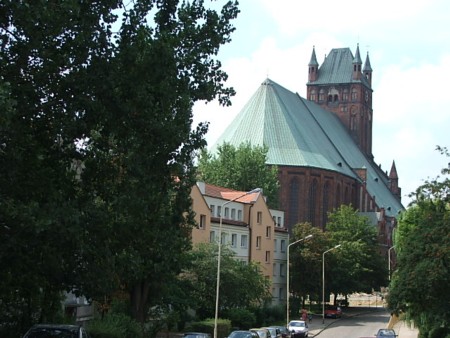
The cathedral
In front of the church stands a large bell, the St. James bell (weighing 5.7 tons), which dates from 1682. The church also houses a rectory from the 14th century. The decoration of the church is very modest, yet very valuable. The decorations are taken from various old churches in the Szczecin area. There is an ancient altar in the form of a late 14th century triptych, a 15th century pietá, an ancient baptismal font, tombstones and sarcophagi. Below the altar is a relic (saint) of St. Otto von Bamberg. The windows are decorated with stained-glass windows (a total of 87 square meters), which represent the Virgin Mary with Jesus and the Holy Spirit. In the church several concerts take place, both instrumental and choral music.
Brama Portowa (Port Gate):
From the small viaduct that goes over ul. Wyszyńskiego close to the cathedral, you can see Brama Portowa, which is one of the 2 preserved gates from the city's fortifications. The port gate was built in the years 1725-1740 in Baroque style.
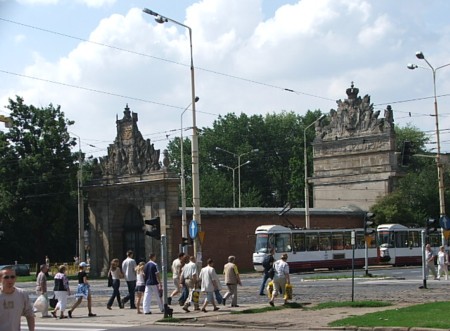
Brama Portowa
From Plac Grunwaldzki to the northwest:
Northwest of the Old City with the castle and the cathedral is another part of central Szczecin, which is to some extent comparable to the neighborhood of the Arc de Triomphe in Paris. That's the area around Place Grunwaldzki . The streets and city squares are here planned in radiant form with Plac Grunwaldzki in the middle. If you start the trip from pl. Żołnierza Polskiego and passing Aleje Jedności Narodowej you come across Plac Grunwaldzki, on to University of Szczeciński (University of Szczecin), and later one has Szczecin City Hall on the right hand and Filharmonia Szczecińska (Szczecin Philharmonic Orchestra Building) on the left. Then follows Place Jasne Błonia with the Pope's (John Paul II’s) monument. Jasne Błonia (The Light Meadows) is known for over 200 plane trees (tree of the genus Platanus). Furthermore you come to a 100 year old park, Park im. J. Kasprowicza (JK Polish poet). In the middle of the park lies Lake Rusałka, an amphitheater and a dendrological garden. Near the park, at ul. S. Wyspiańskiego has a tennis court and an ice stadium.
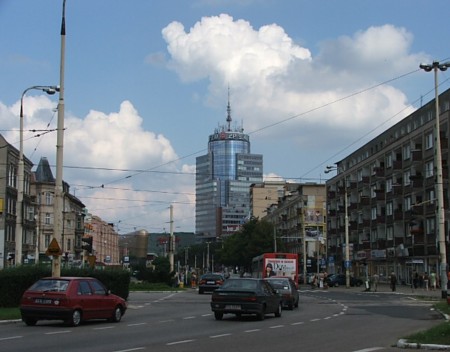
Street in central Szczecin: ul.Wyzwolenia seen to the north. The distinctive high-rise building in the background is part of the large PAZIM complex, which contains, among other things. The Radisson SAS hotel and the Polska Żegluga Morska shipping company
Connections to Denmark:
Szczecin has been cooperating with the municipality of Esbjerg since 1991.
Szczecin is the seat of a Danish consulate.
Street map:
Plan Szczecina
Accommodation:
Booking.com
Stettin Restaurant & Shopping Guide: Hotels
polhotels.com / Szczecin
Noclegi
Witamy w Szczecinie: Hotels
Eating Out:
Gastronomia
Restauracje
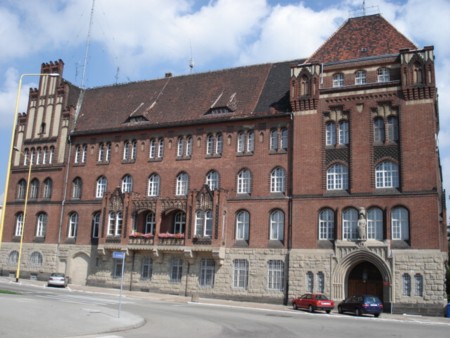
Police building on ul.Małopolska
Other Internet sites and sources
Szczecin.pl (Polish, English, German)
Stettin Restaurant & Shopping Guide (Danish, eng., German)
Szczecin on the Internet (Meadow.)
Szczecin – Capital of Western Pomerania (Meadow.)
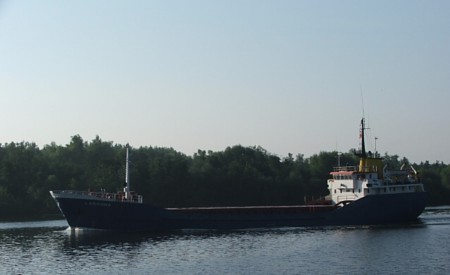
Sailing on Odra off the northern outskirts of Szczecin. The island on the other hand is called Wyspa Dębina
Translated into English by Google Translate. Spangshus.dk accept no liability for any errors or omissions in translation.
Map

Rating
Search
Most used tags
churches (205) Castles (86) Monasteries (79) Town walls (74) Lakes (71) Town halls (67) Rivers (65) Castles1 (62) Mansions (55) Museums (51) Regional museums (38) Town gates (36) Abbey churches (35) Castle ruins (30) Cathedrals (26) Forests (25) Health resorts (24) Water sports (23) Mounds (23) National parks (22)Click for all tags
Denne side er også tilgængelig på dansk. This page and contents is (c) Copyright 2018- www.spangshus.dk. Based on Inviator software by ISCA Software